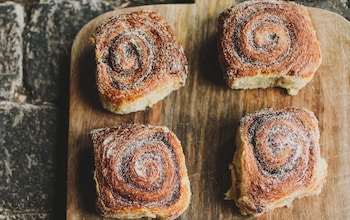The RHS Chelsea Flower Show made a return to Royal Hospital Chelsea today for this year’s festival of plants, flowers, trees, lawns, topiary and everything in between. For gardening enthusiasts, this is a chance to get up close and personal with the ultimate tastemakers in the green-fingered world.
This year there are 16 gardens competing in the Show and Sanctuary Gardens categories, each of them vying for Best in Show or a coveted Gold medal, with Silver Gilt, Silver and Bronze awarded to the runners-up. Another 15 smaller gardens are up for contention in the All About Plants and Balcony & Container Garden categories, so there’s plenty to learn from, no matter how big or small your green space is.
As ever, there’s an impressive variety of exhibitors this year, ranging from Netflix, which has created a Bridgerton-themed garden, to the Japanese master gardener who has crafted a space just for his own personal pleasure, to the annual raft of charity gardens brought to the show by Project Giving Back.
Since rewilding caused a stir at Chelsea a few years ago, the designs this year have stepped back from that particular precipice to a more “curated” look. However, that’s not to say biodiversity and ecology have been abandoned. Look out for cleverly designed anti-flooding gardens, self-sustaining plants, and even more attention paid to the role of fungus in keeping gardens healthy.
Chelsea has been criticised in recent years for its focus on rewilding and more natural planting, in contrast to the lawn-style refinery of years gone by. This year’s show strikes a balance; gardens explode with life, plants bursting out of beds in all directions, though designs are still carefully considered, fitting around high-concept water features and colour palettes which illuminate the themes of each garden.
Above all, this year’s Chelsea Flower Show gardens are full of the invention, wit, colour and charm that horticulture fans have come to expect from the most famous gardening show of all.
Each of the exhibits is judged by a pool of gardening experts from across the horticultural industry. The gardens are assessed on plants (nomenclature, health, quality and vigour, absence of pest and disease, range of plant material and relevance), overall impression (impact, creativity, balance and scale), and endeavour (the difficulty of growing the plants and of staging the display, and originality).
Inspired by the Japanese art of shinrin-yoku, or forest bathing, this garden aims to help visitors awaken their senses and reconnect with nature. Designer Ula Maria has created a large flint wall, chosen for its texture and form, which is supposed to be reminiscent of muscle cells. This will be a tool for explaining the effect that muscular dystrophy has on a person’s body. At the garden’s centre is a large flint-walled “hub”, which is intended to be a meeting point for patients to be able to discuss their experiences outside of the clinical environment. The garden will be relocated to the Institute of Developmental and Regenerative Medicine, in Oxford.
Sponsor: Muscular Dystrophy UK


One of the many Chelsea gardens at this year’s show that aim to take a look into the future of gardening, this one casts visitors 50 years into the future. Focusing on sustainable water management, designers Tom Massey and Je Ahn are showcasing an array of colourful, drought-tolerant plants including Pyramidalis, Hottonia palustris and Hesperaloe parviflora. A large natural pond filled with boulders lies at the entrance to the garden, crossed by bridges and pontoons to give a sense of exploration. A unique and organic-looking pavilion made of weathered steel harvests rainfall to filter down into the garden landscape.
Sponsor: WaterAid


Celebrating the restorative power of green spaces in urban environments, designer Robert Myers has been inspired by the architecture of St James’s church in central London, its bombing during the Second World War, and its gardens. In fact, this garden, with its Yorkstone paving, Portland stone copings, window and archway mouldings, brick planter walls, and small pool fountain, will form the foundation for a brand-new garden at St James’s church to open later in the year.
Sponsor: St James’s Piccadilly


In this garden, designer Tom Stuart-Smith has used plants contributed by the National Garden Scheme’s members to create an “edge of woodland” theme. The focal point is a timber hut at the back of the garden, perfect for a celebratory tea and cake. The style of the garden is supposed to evoke the scheme’s increasing support of therapeutic gardens, as well as highlighting the diverse portfolio of gardens which are opened through its efforts. A native hedge encloses the garden, giving it an intimate feel and providing a sense of refuge, perfect for a Maggie’s Cancer Centre at Addenbrooke’s Hospital, in Cambridge, where the garden will eventually be relocated.
Sponsor: The National Garden Scheme



Can a garden possibly capture the feeling of being autistic? Designers Sophie Parmenter and Dido Milne are doing their best by creating a series of spaces, broken apart by cork walls to represent different interactions. This is to represent “masking”, the process by which people with autism hide their tics, either consciously or unconsciously. At the centre of the garden, there’s a central sanctuary with a mesmerising sculpture, alluding to the mind’s complexity and beauty. You’ll find a wetland meadow and a river birch woodland contained herein, with a vibrant colour palette throughout.
Sponsor: The National Autistic Society



This garden is inspired by that of Octavia Hill, a co-founder of the National Trust and a keen gardener, who believed in “the healthy gift of air and the joy of plants and flowers”. Conceptually based on the idea of an urban garden in a brownfield site, the garden is a plant-filled wildlife haven with plenty of wooden seating to encourage connections between visitors to it. A steel-lattice canopy structure in the pattern of a dragonfly wing forms a habitat hub for the wider garden, with bird boxes and a walkable stream providing other habitats for wildlife.
Sponsor: Blue Diamond with the National Trust


Inspired by the recolonisation of redundant slate mines in North Wales by plants, Matthew Childs’s design features a rising and falling water level. As the water level drops, a slate monolith looking like a tombstone appears, creating a bridge to 2030, when the Terrence Higgins Trust hopes there will be no new HIV diagnoses in Britain. Whereas the tombstone was once a symbol of fear, this garden transforms it into something else. Boulders from North Wales are scattered throughout the gardening, gradually moving from an ornamental garden to a more natural look at the back.
Sponsor: The Terrence Higgins Trust



Designed by stroke survivor Miria Harris, this garden is based on her own recovery and the stories of other stroke survivors. It is meant to be as peaceful and sensory as possible. Colour, fragrance and the sounds of tumbling water will help those with visual or mobility impairments find their way around the space. Interconnected pathways through the contoured landscape acknowledge just how difficult recovering from a stroke can be, fraught with ups and downs. However, naturally built walls create spaces to rest and be with loved ones. A bridge across the stream that runs through the garden is a metaphor for the mental, physical and emotional connections that must be rebuilt after experiencing a stroke.
Sponsor: Stroke Association



This garden is inspired by the collaboration of the various sponsors who have worked together to support Burmese health workers who treat people with terrible skin conditions. With a huge range of plants, all chosen for their Burmese origins, there are several zones to symbolise the diversity of Myanmar and its people. Look for the ruined stupa, a stilt house with views of the cascading waterfall, and carefully planted colour beds.
Sponsor: Burma Skincare Initiative with the support of Sanofi, British Dermatological Nursing Group and The No7 Beauty Company


Designer Giulio Giorgi has created a sensory haven to bring joy, hope and escapism to children undergoing cancer treatment. The dominant feature of the garden is the raised beds, made from perforated clay blocks. The planting is made up of soft-touch plants, fragrant herbs and mosses, designed to encourage sensory exploration, all picked for being low-maintenance and easy to garden. A seating area provides a restful spot for children and their families. Golden sculptures on bamboo appear like little suns throughout the garden to offer hope.
Sponsor: World Child Cancer

Celebrating the 200-year anniversary of the National Gallery, designer Catherine MacDonald has framed her garden with, well, frames. A series of bespoke lightweight metal arches allows different views of the garden’s features, inspired by Canaletto and Claude paintings, and by the fabric and intricate details in works by Klimt and Menzel. The garden is divided up into rows, separated by metal grates that break up the planting, which springs from gravel beds. There’s also the influence of artists such as Seurat, van Gogh and Monet to be found.
Sponsor: Boodles

It’s a phrase that we often hear, but how do you express is in a garden? Baz Grainger is attempting to do so a garden which, like the financial landscape of a multi-generational family, can appear impenetrable and unruly. Even so, there are elements that bring refreshment and continuity, such as an overhead water feature leading to a well. This symbolises the coming together of a family, and calm reassurance, plus a fun place to wish for financial prosperity in the future. There’s also a large seating area where families can come together to discuss financial matters.
Sponsor: Killik & Co

Created by legendary designer Kazuyuki Ishihara, this garden is no more complicated than simply what makes him happy. You’ll find autumn leaves, the sound of a waterfall and a small pool with a stream. Flowers bloom from within mossy beds and there is a little motorcycle tucked in one corner – a favourite vehicle of the designer. A small house exists within the garden, made with green walling so that it is incorporated into the garden design. It’s strikingly similar to the designer’s Gold-medal-winning 2023 effort, but no less lovely for it.
Sponsor: G.Lion


As this year’s “big name brand” sponsor, the Netflix garden will surely attract a lot of attention. Designed by Holly Johnston after the iconic Regency-set series Bridgerton, this garden offers plenty to explore. Based around the character of Penelope Featherington, the main character of the recently released third series, the garden represents an evolution from wallflower to muse. The entrance to the garden is muted, aside from pops of colour from Erysimum ‘Bredon’, better known as the wallflower. A circular moongate leads to a Regency-inspired water feature and sunken seating area, surrounded by a sophisticated palette of lilac, blue and pink.
Sponsor: Netflix (Bridgerton)


With the weather we’ve seen in Britain during the early part of 2024, there’s a timely quality to this space, designed by Naomi Slade and Ed Barsley. The garden uses dense planting to slow the flow of heavy rainfall into the ground, capturing and storing it for later use. A shady, sunken spot in the centre of the garden forms a stream that channels the rainwater into a feature pond. Large tanks which double as ornamental ponds are also placed at one end of the garden to store water for later use – smart technology can release that water ahead of more rain. Given that one in four UK homes is at risk of damage due to flooding, this garden might offer just the inspiration modern gardeners need.


Designers John Warland and Emma O’Connell have created a space all about the healing power of gardening, woven together with a soft, undulating wooden willow-like structure which evokes fabric. There are smaller breakout spaces for therapy sessions to take place beneath the canopy of self-sustaining and self-seeding plants and trees, chosen for their ability to cope in extreme environments. There’s even a communal bread oven to bring to life the concept of breaking bread with others.
Sponsor: Freedom From Torture

Cold plunge pools have become a trend at Chelsea in recent years, and the Ecotherapy Garden designed by Tom Bannister features this year’s most recent example. Designed as a small London courtyard, it has a Thames yellow brick wall, a rill with a cascade, and hanging greenery that envelops the space. The aim is to rejuvenate physical and mental wellbeing, hence a small bench for quiet contemplation when you get out of the cold plunge pool.

As the name suggests, this little garden created by Lucy Mitchell is all about the coastal landscape of the UK, specifically shingle beaches. Plants showcased are those specially adapted to living under a constant barrage of salt water, in poor-quality soil and under blazing sunshine. The rest of the garden – weathered timber, rusty steel railings and repurposed steel pipe planters with a pebbly seating area – showcases the British coastline in all its glory.
Sponsor: MGR

The dominant article in this space, designed by Sonja Kalkschmidt, is the striking black charred-wood pod at its centre. Designed to contrast with the lush green foliage found around the rest of the garden, the pod is a space to relax, unwind and get away from the relentless nature of online life. The rest of the garden is wrapped in greenery and has a hanging tree, to provide a relaxing and comfortable space to sit and rest.

Turning an unloved, ugly little square of grey concrete into a majestic, cosy garden space is something of a speciality for gardeners at Chelsea, and designer Elisabeth Wright-McCalla continues that trend here. With a central water feature, a living wall, beautiful tiling and raised planters forming a comfortable seating area, this is just the type of garden to inspire anyone who lives near to a little urban plot needing some love.
Sponsor: LuxUnique, Living Walls, ICS Chimney Sweeping Group

Designed by Sam Proctor as a love letter to the Chilterns chalk streams, this garden is all about saving water. Though hosepipe bans have caused gardeners no end of stress in recent years, this miniature garden offers plenty of hints about what can be done, with interconnected self-watering planters connected to the building’s rainwater gutters via rain chains and slimline water butts. The planters are put together minimally with just a few plants, including Cornus kousa and Camassia to keep the eye bouncing around the space.
Sponsor: Affinity Water

Ever wish you could step out of your doors and into a jungle? Then take inspiration from designers Mike McMahon and Jewlsy Mathews, who have created a compact urban jungle with a tiny footprint. Look out for exotic plantings from Mathews’s ancestral home in Kerala, India, with a recycled paper backwall, which evokes the layers of the jungle ecosystem. Bird nests, bat boxes and a small pond are integrated into the design to give this mini-jungle some life, and seating inspired by unfurling fern fronds offers a tranquil and relaxing place to sit.
Sponsor: Addleshaw Goddard

Created from repurposed farmyard materials and felled trees found by designer Thomas Clarke, this shaded garden provides a place to relax and breathe. Scented flowers including Taxus baccata and gently moving grasses provide a calming, practical space for reflection, with seating and handmade floor tiles. The goal is to show that authentic materials can be beautiful and practical in another form.
Sponsor: Children With Cancer UK

Inspired by both British and Japanese gardens, this no-waste, plastic-free balcony is all about living in harmony with our fellow creatures, plants and fungi. The garden contains tips on how to create a no-waste garden, using pruned twigs and leaves to promote the retention of soil moisture, bacteria and fungi growth, softening soil for cultivation and reducing the need for chemical fertilisers. There are also plenty of edible plants, including a yuzu tree, a hazelnut tree, a fig tree and many kitchen herbs.
Sponsor: Tomie’s Cuisine, Alice Garden Design, Takehiro, Niwaki

A holiday in balcony form, this miniature garden is designed to transport visitors to Venice, a city frequented by designer Michela Trinca as a child. However, despite the Italian theme, all the planting, including climbing bougainvillaea and potted lemon trees, is designed to be able to withstand the British weather. There’s even a comfortable pergola where you can rest and get some shade, even on those rare days where the British and Italian climates happen to coincide.

It takes some guts to bring a garden to Chelsea, but this garden takes that literally with a design that is all about the gut microbiome. Designers Chris Hull and Sid Hill have chosen edible plants which offer a probiotic feast to nourish the human microbiome and safeguard against bowel-related illnesses. Look for traditional log beehives, which provide a home for pollinators to access the garden. There’s also a human “hive” where people can relax together.
Sponsor: Bowel Research UK

Despite the name, you won’t need to spend a whole day exploring this little garden created by designer Daniel Bristow. Highlighting The Size of Wales charity’s mission to save tropical forests, visitors will find 313 individual plants, the exact number of tree species found, on average, in one hectare of a tropical forest. Two “little roofs” sit on stilts, just big enough to shelter a single person each from the rain, calling to mind the precariousness of our hitherto comfortable existence. Look out for the fungus wall, highlighting the role of fungi in aiding plant life.
Sponsor: The Size of Wales

Designed by Katherine Holland to provide a safe, comfortable respite for those experiencing grief, this garden features a three-person seated area for people to talk about their experiences of losing someone. Plants have been chosen for their sensory qualities, so look out for Tilia henryana, which has textural leaves and fragrant flowers, and soothing green and grey colours which don’t distract from the intimate atmosphere of the space.
Sponsor: Sue Ryder

Inspired by the Panathlon Foundation’s desire to offer more sporting opportunities to young people with special educational needs, designer Penelope Walker has created a colourful, enticing space. The curved trunks of Malburg trees, undulating topography and winding path all come together to lead the eye around satisfyingly smooth curves which symbolise normalising difference.
Sponsor: The Panathlon Foundation

Inspired by the “smoothie bikes” that social enterprise Pulp Friction (which helps those with learning difficulties and/or autism to get into work) uses to get people active and excited about raising for charity, this garden is meant to reflect centrifugal forces. Designers Will Dutch and Tin-Tin Azure-Marxen have created a central “wheel” with recycled fire hoses donated by Nottinghamshire Fire and Rescue Service to create a circular plaza where people can meet. The planting is mostly edible or in some other way utilitarian, with hazel and birch creating a charming canopy.
Sponsor: Pulp Friction CIC

Of all the things Chelsea visitors have come to expect over the years, the words “edible skatepark” are probably not high on the list. Still, inspired by Planet Good Earth’s mission of providing food education to the next generation, this forest garden landscape, designed by Betongpark and Urban Organic, could be just the ticket. A central skate ramp adds a sense of fun to what might otherwise be a safe and bucolic scene. Apple and pear trees form a canopy with a shrub and herb layer below which includes fruits, edible flowers/foliage and honeyberries.
Sponsor: Planet Good Earth CIC

Disclaimer: The copyright of this article belongs to the original author. Reposting this article is solely for the purpose of information dissemination and does not constitute any investment advice. If there is any infringement, please contact us immediately. We will make corrections or deletions as necessary. Thank you.



